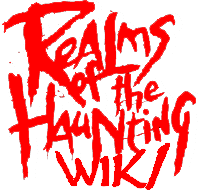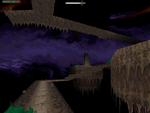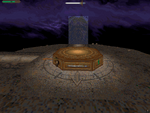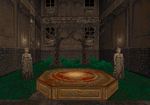|
|
| The Tower | |

| |
| Device of Passage | |
| Guide | |
The Tower is a system of floating landmasses of varying size which are linked through narrow platforms. It serves to connect the four Realms: Heled, that is Earth; Raquia, the Realm of Spirit; Arqua, the place of Divinity; and Sheol, the abode of Hell.
Adam's and Rebecca's first voyage to the Tower takes place in Chapter IV: Tales from the Tower after meeting the Gnarl and receiving the Egyptian Masks which are necessary to use the teleporters known as Tower Gates. They are welcomed by a man named Raphael who reveals himself to be the guide of this place, the last of its Gardeners.
I was wondering why the developers chose to call this place Tower. Maybe it's an implication to the verticality of such a structure and the theologically described layers of the world, some of which we visit upon our journey through the Realms of the Haunting, namely Heled, Raquia, Arqua and Sheol. By this interpretation, the Tower contains all of these layers, Sheol (Hell) being at the bottom, followed by Heled (our Earth), then Raquia (the second heaven), and Arqua (the Divine realm) being the topmost layer.
In the Rider Waite tarot deck, the Tower is the sixteenth trump or Major Arcana card, depicting a burning tower being struck by lightning or fire from the sky, its top section dislodged and crumbling. Two men are depicted in mid-fall, against a field of multicolored balls. As such, the Tower card has become associated with sudden, disruptive, and potentially destructive change. It may be a reference to the biblical story of the Tower of Babel, where God destroys a tower built by mankind to reach Heaven.
Florentine's Journal[]
In his Journal, Florentine reserves a generous amount of space for describing in detail the nature of the Tower. Primarily, Florentine and his acolytes used the Tower to travel to the Chamber of the Soulstone which is situated in the Realm of Sheol. Inside the Chamber they held the ceremonies of breaking the first six Shards and Seals.
He states that "[t]he Tower is as useful as is dangerous."[1] The perilous aspect can be mainly attributed to the "gibbering madness of the Ire"[2], an ever-present entity in the Tower which relentlessly hunts and devours the souls of unwary travellers. For example, there was one instance when Florentine would send out no fewer than 22 acolytes to the Tower of which only one returned in a state equalling delusion.
A similar incident occured much later and is described in the entry of October 31, 1673. Supposedly, of six acolytes who Florentine sent to the Tower on October 28 of the same year with the purpose of hunting down the Dodger, none had returned.[3]
Later on, Florentine relates his discovery of three white feathers dropped at several tower gates whenever he travelled to the Tower.[4][5][6] He assumes that a presence other than the Dodger must be travelling through the Tower. His hypothesis is supported by the fact that one of his Yielders was driven from its assigned task as it was being attacked and "about its body were deep marks that should have been made by claws but [infact were the wounds of some blade]."[5]
In his entry of April 15, 1895, Florentine recapitulates a conversation with his confidant Belial who had disappeared three days earlier and who regretfully and angrily disclosed to him after his return that the Gardeners had infact returned to the Tower and that they were responsible for the deaths of the Urges and Yielders which Florentine had placed on each gate for safety measures. As the Gardeners would certainly complicate Florentine's efforts to travel to the Chamber of the Soulstone, he states that he has to prepare for a possible assault on the Tower.
The Gardeners[]
Raphael is the last of the guides of the Tower, the last of its Gardeners. According to him, some of the creatures that Adam and Rebecca encounter while travelling through the Tower were once Gardeners. He also says that the Ire has transformed them into these hideous monsters and that they now function as its eyes and ears.
Florentine relates one of his acolyte's experience with a gardener in his journal, precisely in the entry of January 15, 1330. Said acolyte, Thomas, ostensibly encountered within the Tower someone who called himself the Gardener. Apparently, the Gardener aided Thomas "in his escape only moments before the gibbering madness of the Ire fell upon him". Florentine is sceptical about Thomas' account as his then-confidant Belial claims that "the last of the Gardeners perished at the Fall of the Stone."[2]
In his entry of March 15, 1330, Florentine talks about a manuscript which he has had sent from France and which constitutes French magician's account on his travels through the Tower during the 13th century. There is no mention of any Gardeners in this document. It is, however, just a fragment of a much larger body.
In the entry of April 15, 1895, Florentine writes that Belial regrettably informed him that "the Gardeners had in fact returned to their precious Tower despite his promise that they had all perished at the Fall of the Stone."[6]
Tower Gates[]
The ![]() Tower Gate is a device in the form of an octagonal, magically-charged plinth which enables one to travel to the Tower and the other Realms. After having visited one of the other realms and completed the assigned task there, the power of the tower gate leading to this realm usually becomes depleted which makes another entrance to that realm impossible.
Tower Gate is a device in the form of an octagonal, magically-charged plinth which enables one to travel to the Tower and the other Realms. After having visited one of the other realms and completed the assigned task there, the power of the tower gate leading to this realm usually becomes depleted which makes another entrance to that realm impossible.
Some of the Tower Gates that Adam and Rebecca discover upon their journey through the house don't work anymore. Rebecca comments that they have, however, a residual trace of power left. To her it appears as if someone is trying to stop something from either entering or leaving the Tower. Usually, these dysfunctional gates are scattered with dead rats and spilled with blood. On a tower gate inside one of the courtyards of the house, Adam and Rebecca encounter the Dodger, surrounded by a cloud. Shortly after, it disappears again.
Kudurrus[]
In various parts of the Tower we come across menhirs whose primary function is to guide travellers on their way through the Tower. According to Rebecca they are called Kudurrus which is a Sumerian name meaning path marker. Into their stony surface are carved the rune symbols of the Realms and upon touching these glyphs, the traveller hears Raphael's voice giving him advice on where to find a specific Realm, such as "Raquia lies to the north, traveller." Sometimes, the glyphs are glowing in an orange light and touching them will restore a certain amount of health, an effect we could speculatively attribute to the workings of Raphael, who in biblical accounts is assigned with the faculty of healing.
Similarities[]
The Wheel of Time[]

The Ways (concept artwork by Sam Wood) © Wheel of Time wiki

The Tower in Realms of the Haunting
For a closer examination of the similarities between Realms of the Haunting and Robert Jordan's series of fantasy novels, please refer to this page.
The Tower and the Ire show significant similarities to some aspects in The Wheel of Time books, precisely the so-called "Ways" and the "Machin Shin". According to the Wheel of Time wiki, the Ways are "an area outside of reality," whose pathways are suspended platforms and bridges with the purpose of linking various so-called Islands which "are marked with large slabs of stone, labelled with Ogier Script, called Guidings." As such, they appear to have a similar function as the Kudurru monoliths in the Tower.
Initially, the Ways used to be a bright location filled with greenery, but during the War of the Hundred Years "the Ways began to grow dim [and] people began to avoid travelling the Ways, and some that did return came back mad, raving and screaming about Machin Shin, the Black Wind."[7] In the Tower, we find remnants of vegetation, and at some point, the Tower was tended to by a group known as Gardeners. The so-called "War of the Hundred Years" in the Wheel of Time books conjures up memories of the "Battle of the Stone" in Realms of the Haunting.
The Ways allow those who know the secret of traveling them to cover great distances in very short periods of time, and they are believed to have been created based on the study of 'Portal stones'. A portal stone is a now forgotten and obsolete means of travel, bound to one location and resistant to being moved. The portal stones are made of a gray stone and are three spans high and a full pace thick. They are covered top to bottom with deeply incised inscriptions and usually worn to an extreme degree.
Also, as Tower Gates are used to travel between various locations in Realms of the Haunting, similar devices exist in the universe of Wheel of Time, so-called waygates. A waygate is a doorway carved out of stone; each Waygate has two Avendesora leaves on it, one on the outside and one on the inside. This makes it possible to lock waygates by putting both leaves on one side. When one moves the Avendesora leaf, the waygate turns to living plants and two doors swing open to reveal a smoky, mirror-like barrier, allowing access to an alternate dimension.
Undying: Oneiros[]
http://i0.wp.com/bloody-disgusting.com/wp-content/uploads/2015/09/clivebarkersundying5.jpg?fit=960%2C720 Nota bene: Having not played Clive Barker's Undying as far ahead yet myself, I became aware of this intriguing analogy courtesy of Jaz on the RPGWatch Message Board.
Looking at some visual impressions of the game, I've found that the floating landmasses of the Tower also bear some geographical similarities to the rubicund Oneiros level in Undying (or vice versa, rather, considering the latter game was released after ROTH, in 2001). Unfortunately, the fanproject, mixing ROTH and Undying, has never been finished.
Tales from the Tower (Walkthrough)[]
Chapter IV Tales from the Tower[]
Having passed the Gnarl's test and now in possession of the Egyptian Masks, we're finally able to access the Tower. As we step off the Tower Gate, we make the acquaintance of Raphael, who's amidst preparing a fish on a fireplace and introduces himself as the guide of the Tower, the last of its Gardeners. He's warning us about the Ire roaming around this place and gives us a brief overview on the four different Realms:
![]() Raphael - The Guide
Raphael - The Guide
Moving up the flight of stairs leading off from the Tower Gate and coming across a quartet of pillars placed around a floor compass of sorts, we take the opportunity to familiarise ourselves with this place's architecture. Filled with wonder at the sight of floating landmasses, we're surprised by disconcerting voices sporadically permeating the humming noise that is constantly present in the Tower.
As we follow the fairly straightforward path, our attention is drawn to a menhir of sorts, which Rebecca identifies as a Kudurru, a Sumerian word denoting a path marker; and indeed, upon closer inspection of the rune symbols that are carved into the stone, we receive directional advice from Raphael on where to locate a certain Realm. Additionally, when radiating an orange light, the runes will restore some of our health upon touch.
The next architectural element to excite our curiosity is a portal of shimmering light which we boldly decide to tread through, considering we've already seen one of those inside the Mausoleum, when we entered the Throne Room and received the marks. Emerging alive on the other side of the shimmering doorway, we spot a golden pillar that's making Rebecca feel nervous, as she senses a faint but still very powerful magic emanating from it. Eventually we reach another Tower Gate which bears the symbol of Heled. Remembering what Raphael told us, we stand on the plinth and take off the masks. If you wish to follow this walkthrough chronologically, please click on the following icon to continue reading about our return to Heled and exploration of Memory's Garden.
Chapter V The Offering[]
Stepping onto the Tower Gate in Memory's Garden and now in possession of the Rune Guide, we find ourselves back in the Tower and uneventfully backtrack along the path that originally led us to Memory's Garden, guided by the delectable smell of Raphael's cooked fish, until we end up at the first Heled Tower Gate. If you're interested in reading our succedent search for and exploration of the Caverns and Florentine's Observatory, please click on the following icon to continue reading about our return to Heled.
Chapter X The Key of Tears: The Journey to Raquia[]
After stepping off the Tower Gate, we're immediately attacked from behind by a ![]() Khulkith, a red flying enemy that shoots magical spheres from afar. After that startling first ambush, we have some time to take in our unfamiliar surroundings, spotting to our side a brown, unusually peaceful creature, a
Khulkith, a red flying enemy that shoots magical spheres from afar. After that startling first ambush, we have some time to take in our unfamiliar surroundings, spotting to our side a brown, unusually peaceful creature, a ![]() Nephilim[8], seemingly stuck to its position in front of a Kudurru and mauling a club at us if we get too close. By inspecting the waystone, Raphael will inform us that Raquia can be located in the east. Hence, looking in the direction of the orange arrow on the ground, Raquia lies to our right (cf. our complete
Nephilim[8], seemingly stuck to its position in front of a Kudurru and mauling a club at us if we get too close. By inspecting the waystone, Raphael will inform us that Raquia can be located in the east. Hence, looking in the direction of the orange arrow on the ground, Raquia lies to our right (cf. our complete Map of the Tower). Proceeding onwards from the Tower Gate, we spot a second Nephilim to our right, deciding to move ahead through the Shimmering Gate instead until we come across a junction. Taking the left path would mislead us to a dead end, hence we proceed along the path to our right, passing yet another Nephilim on our way, that again seems to be stuck in between a quartet of pillars. Moving through another Shimmering Gate and down a flight of stairs, we find ourselves at another junction. At this point, taking the first path at hand will prematurely lead us to the Tower Gate to Arqua. Raphael will kindly inform us that, for now, we lack the devices to enter the Realm of Divinity:
![]() Raphael - Gate to Arqua
Raphael - Gate to Arqua
![]() Raphael - Gate to Raquia
Raphael - Gate to Raquia
![]() Raphael - Warnings
Raphael - Warnings
![]() Raphael - Knight's Blade
Raphael - Knight's Blade
![]() Raphael - Eyes and Ears
Raphael - Eyes and Ears
![]() Raphael - the Quest
Raphael - the Quest
![]() Raphael - Rite of Passage
Raphael - Rite of Passage
![]() Raphael - Precious Time
Raphael - Precious Time
Hence we backtrack to the afore-mentioned junction and proceed along the other path at our disposal, moving up a series of stairs and through another shimmering gate, after which we pass by a lowered Tower Gate featuring a red cross in the centre which isn't going to work at this point. After greeting another Spite and walking through one more Shimmering Gate, we spot another flying Khulkith off in the distance to our left, after whose defeat we descend one last staircase before eventually happening upon a path that spirals upwards to the portal to Raquia. If you wish to follow this walkthrough chronologically, please click on the following icon to continue reading about our exploration of Raquia.
Chapter XI Captive Angel: Freeing Hawk[]
After successfully completing Raysiel's trials in Raquia and now in possession of the Key of Tears, we're finally able to return to the Sarcophagus in the Mansion's Study and free Hawk from his prison. Back in the Tower, we move down the spiralling path and follow the straightforward route that originally led us to the portal to Raquia, until we find ourselves back inside the Temple of the Morning Star. If you wish to follow this walkthrough chronologically, please click on the following icon to continue reading about our return to Hawk's Prison.
Chapter XIII Sword of the Dragon: The Journey to Arqua[]
If you wish to follow this walkthrough chronologically, please click on the following icon to continue reading about our adventures in Arqua.
Architectural Impressions[]
Dysfunctional Tower Gates[]
Maps[]
Script[]
Discussing the Tower[]
| “ |
Adam: What do you make of the Tower - do your psychic powers give you any kind of insight? |
” |
Discussing the worlds of the Tower[]
| “ |
Adam: What's a Tower Gate? What is one exactly? |
” |
Discussing the Tower Gates[]
| “ |
Adam: What do you think the Gnarl's role is in all of this, Rebecca? |
” |
Discussing the Tower and Florentine[]
| “ |
Adam: Shed any light on the Tower? |
” |
Discussing the Tower further[]
| “ |
Adam: We already know that Florentine used the Tower to travel to Sheol and the Chamber of the Soulstone. |
” |
Reflecting on the Tower[]
| “ |
Adam: The Tower. Strange place; and Raphael... well what should I make of him? The last of the Gardeners... and the Tower itself, he claims he's [its] guide. According to Florentine's Journal, he used the Tower too. Like a Goddamn highway. |
” |
The Voices[]
While travelling through the Tower, voices can be heard at irregular intervals. These represent all the souls that the Ire has devoured throughout the years. Here are some examples:
Claude Florentine[]
- My name? My name is hate, man-child.
- We all labor against our own cure. Death is the cure for all disease.[9]
- The Seals are fast. Where is the power you promised me? Answer me, Abaddon! (Unsure if it's him.)
- I will avenge and kill the Son of Adam.
- There is a Reaper whose name is death and with his sickle keen, he reaps the bearded grain at breath and the flowers that grow between.[10]
- For I have seen, and yet I do not fear of him.
- Give me the blood of Man.
- And he that will his health deny, down among the dead to lie.[11]
Charles Randall[]
Miscellaneous[]
- And to you Father, what does Thou ask of me?
- Daughter, come from there and see the fire in the sky.
- Child of Heled. Sleep - sleep and cometh upon thy wings to me.
- It is Raym. And with him follow the hordes of Hell.[12]
- By the Laws I cannot refuse, yet what you do Florentine is against the laws set before. What I do I do because for me there is no choice.
- ... with the fires of Wrath, he shall consume...
- And the moon shall turn as blood and the Sun as sackcloth, in the last days.[13]
- Not until the last days, my child. Remember that.
- Stand I say. Stand for the Light. Rally to the walls and fight!
- It shall be here Antoine, here in the forests of Falshire that they shall fall. Then, our spy shall move and Aelf shall fall from within.
- The Yielders are come. Run to the Gates!
- He plots against me. His vision is great but my will is the stronger.
- ... and there to die upon the hill. Take him!
- You hide and skulk within your walls but for you, heh heh, for you, there will be nothing. Do you hear me?
- The beast has fled to the Tower, and with it our bargain. I warned you against making the Dodger your own, Florentine! Now we will all pay!
- It has fallen my Lord. The Chamber is theirs. It was Thomas. The traitor was Thomas.
- The Templars come. Look, there. Above the mount. The legions of darkness are come. To me, to me. Rally to the Banner.
- A man will come. But his face is hidden to me, my Lord.
- Seven are the Stones and Seals. With Thy word, are they enough?
- And in those days, a star will fall.
- ... the minions of the night walk this very hour. Wouldst you see? Wouldst you see how they shall take the Soulstone from them?
- My Master brings good news of the times...
- Come, join me son of Adam. It would be unfair to leave them all to me.
- ... hold him... hold him! Damn it Priest, the wards are failing. Close it up... now. Bind it... do it now. The Dodger is breaking the line...
- Once touched, no man may lay his hand upon the blade.
- And each Seal is his word, lest no Man touch their power.
- Give the command! The associates will fall.
- I have seen the Templars have stood within its walls, but for you there will be nothing.
References[]
- ↑ Florentine's journal, March 15, 1330.
- ↑ 2.0 2.1 Florentine's journal, January 15, 1330.
- ↑ Florentine's journal, October 31, 1673.
- ↑ Florentine's journal, October 1, 1783.
- ↑ 5.0 5.1 Florentine's journal, October 2, 1783.
- ↑ 6.0 6.1 Florentine's journal, April 18, 1895.
- ↑ Ways at the Wheel of Time Wiki
- ↑ Textures, as found in the ROTH/M/ADEMO.DAS folder: "NEPH_C.Brown, tusks, weapon club with.BMP" and "NEPHILIM.:fields of...ha ha!.BMP", the latter description being a reference to the British Gothic rock band Fields of Nephilim; the Nephelim themselves refer to giant-like entities mentioned in the Book of Genesis
- ↑ This is a slightly altered version of this quote from English philosopher Sir Thomas Browne.
- ↑ This quotation is a slightly altered version of the first stanza of the poem, "The Reaper And The Flowers," by Henry Wadsworth Longfellow.
- ↑ Loosely cited from a poem by English writer William Morris, namely "Down Among the Dead Men".
- ↑ According to Johann Weyer's Pseudomonarchia Daemonum, Raym (or more prominently Räum or Raum, respectively) is a Great Earl of Hell, ruling thirty legions of demons. He is depicted as a crow which adopts human form at the request of the conjurer. Raym steals treasures out of kings' houses, carrying them where he wishes, and destroys cities and dignities of men (he is said to have great dispraise for dignities). He can also tell things past, present and future, and reconcile friends and foes.
- ↑ Refers to a passage from the Book of Revelation (6:12).
















![Map-TowerComplete.PNG (247 KB) Complete Map, found inside Florentine's Library. Dated 1588 [sic?] A.D., the cartographer apparently being Florentine, if the signature is valid.](https://static.wikia.nocookie.net/tales-from-the-tower/images/0/04/Map-TowerComplete.PNG/revision/latest/scale-to-width-down/150?cb=20090919142406)